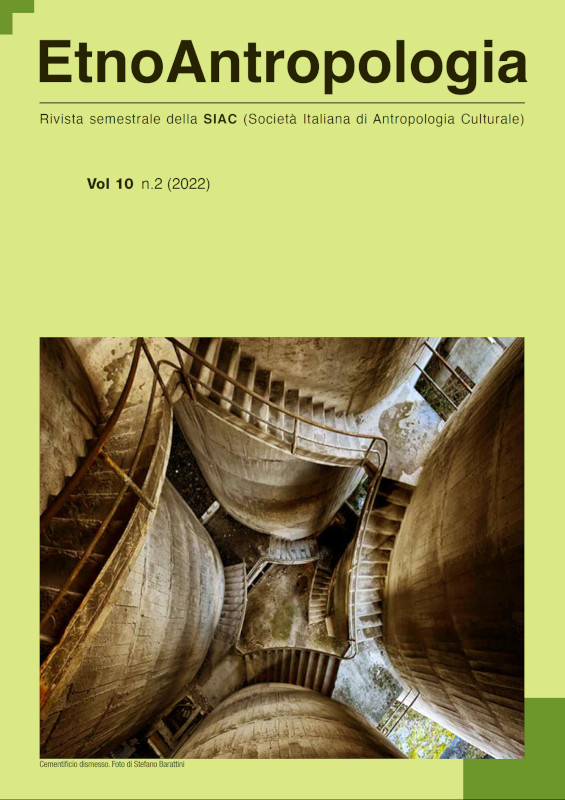Derelict land. Una riflessione sulle fabbriche abbandonate nel territorio biellese.
Parole chiave:
Narratives, Anthropology, Community, BrownfieldsAbstract
The marks left on the ground by the industrial history are a distinctive feature of the Biella landscape. The nineteenth-century origins of the first wool entrepreneurial adventures produced obsolete structures already in the last century, triggering an initial interest in the recovery and enhancement of “historic factories”. Starting from studies about deindustrialization and the effects of the subsequent process of abandonment, the article examines the need to reflect on the presence of abandoned areas, taking into account not only their heritage but also the repercussions on the lives of the inhabitants. Through the meanings that can be found in artistic productions such as movies or novels, and from the description of the “social ruins” caused by the loss of work, an anthropological research path is traced to give voice to the community and to the “cultural drama” caused by a long period of transition [Dudley 1997].
Riferimenti bibliografici
Antonaci F. 2006, Fabbriche, uno sguardo al futuro, Biella: DocBi Centro Studi Biellesi
Berger S. 2021, La Ruhr e gli esiti positivi possibili, in Tempi moderni 2030. Dalla deindustrializ-zazione alle nuove onde dello sviluppo, Milano: Fondazione Giangiacomo Feltrinelli.
Bonfiglioli C. 2019, Women and industry in the Balkans: The rise and fall of the Yugoslav textile sector, Londra: Bloomsbury Publishing.
Capello C. 2017, Rituali neoliberali. Uno sguardo antropologico sui servizi per la ricerca attiva del lavoro, «Etnografia e ricerca qualitativa», 10 (2): 223-242.
— 2020, Ai margini del lavoro. Un'antropologia della disoccupazione a Torino, Ombre corte
D’Aloisio F. 2017, Post-Fordist Work. Organization and Daily Life from a Gender Perspective. The Case of Fiat-Sata in Melfi, in S. Narotzky, V. Goddard (ed.) 2017, Work and Livelihoods. History, Ethnography and Models in Times of Crisis, Londra: Routledge, 77-92.
Dei F. 2008, Un museo di frammenti. Ripensare la rivoluzione gramsciana negli studi folklorici, «Lares», 74 (2): 445-464.
Di Nuzzo A. 2018, Napoli allo specchio. Itinerari napoletani tra etnografia, letteratura e riflessio-ni antropologiche, «EtnoAntropologia», 6 (2): 31-44.
Drouguet N. 2016, L'inconfort du conservateur face au musée "indiscipliné": la mise en exposition dans le musée de société, THEMA, «La revue des Musées de la civilisation», 4:11-22.
Dudley K. M. 1997, The end of the line. Lost Jobs, New Lives in Postindustrial America, Chicago: University of Chicago Press.
Esposito V. 2016, Cartografie implicite e mappe di comunità: per una diversa classificazione dei Beni culturali. «EtnoAntropologia», 4(1): 47-56.
Garruccio R. 2016, Chiedi alla ruggine. Studi e storiografia della deindustrializzazione, «Meridia-na», 85: 35-60.
High S. 2013, Beyond Aestatics: Visibility and Invisibility in the Aftermath of Deindustrialization, «International Labor and Working-Class history», 84: 140-153.
Linkon S.L. 2013, Narrating Past and Future: Deindustrialized Landscapes as Resources, «Inter-national Labor and Working-Class history», 84: 38-54.
Lombardi Satriani L. M. 1995, Introduzione, «Bollettino dell'Associazione Italiana di Cinemato-grafia Scientifica», ottobre: 89-95.
Loperfido G. 2020, The Entrepreneur’s Other: Small Entrepreneurial Identity and the Collapse of Life Structures in the “Third Italy”, in S. Narotzky (ed.) 2020, Grassroots Economies. Living with Austerity in Southern Europe, Londra: Pluto Press.
Marano F. 2007, Il film etnografico in Italia, Bari: Ed. di pagina.
Molé N. J. 2010, Precarious Subjects: Anticipating Neoliberalism in Northern Italy’s Workplace, «American Anthropologist», 112 (1): 38–53.
Neiretti M., Vachino G. (ed.) 1987, La lana e le pietre. Il Biellese nell’archeologia industriale. Le Valli orientali, Biella: Città Studi.
Pandian A. 2019, A possible anthropology: methods for uneasy times, Durham: Duke University Press
Perona G. 2016, Le patrimoine industriel historique et l’identitè du district biellais, in L. Lorenzet-ti, N. Valsangiacomo (ed.) 2016, Alpi e patrimonio industriale, Milano: Mendrisio Academy Press, 56-58.
Pozzi G., Rimoldi L. (ed.) 2022, Pensare un’antropologia del welfare. Etnografie dello stato so-ciale in Italia, Milano: Meltemi.
Ramella F. 1984, Terra e telai. Sistemi di parentela e manifattura nel Biellese dell’Ottocento, To-rino: Einaudi.
Redini V. 2008, Frontiere del "made in Italy": delocalizzazione produttiva e identità delle merci, Verona: Ombre corte.
— 2019, Fabule e Trame. Una prospettiva etnografica su lavoro e movimento nella produzione globale, «Antropologia», 6(2): 135-150.
Rimoldi L. 2017, Lavorare alla Pirelli-Bicocca: antropologia delle memorie operaie, Bologna: Archetipolibri
Strangleman T. 2013, “Smokestack Nostalgia”, “Ruin Porn” or Working-class Obituary: The Role and Meaning of Deindustrial Representation, «International Labor and Working-Class history», 84: 23-37.
Strangleman T., Rhodes J., Linkon S.L. 2013, Introduction to Crumbling Cultures: Deindustriali-sation, Class, and Memory, «International Labor and Working-Class history», 84: 7-22.
Stanton C. 2017, Keeping “the Industrial”. New Solidarities in Postindustrial Places, in S. High, L. MacKinnon, A. Perchard (ed.) 2017, The Deindustrialized World. Confronting Ruination in Postindustrial Places, UBC Press.
Tsing A. 2015, The Mushroom at the End of the World: On the Possibility of Life in Capitalist Ru-ins, Princeton University Press.
Tuck E. 2009, Suspending Damage: A Letter to Communities, «Harward Educational Review», 79 (3).
Walley C. J. 2013, Exit Zero: family and class in postindustrial Chicago, The University of Chica-go Press.
Pubblicato
Come citare
Fascicolo
Sezione
Licenza
Copyright (c) 2023 Manuela Vinai

TQuesto lavoro è fornito con la licenza Creative Commons Attribuzione 4.0 Internazionale.
Gli autori mantengono i diritti sulla loro opera e cedono alla rivista il diritto di prima pubblicazione dell'opera, contemporaneamente licenziata sotto una Licenza Creative Commons - Attribuzione che permette ad altri di condividere l'opera indicando la paternità intellettuale e la prima pubblicazione su questa rivista.
Gli autori possono diffondere la loro opera online (es. in repository istituzionali o nel loro sito web) prima e durante il processo di submission, poiché può portare a scambi produttivi e aumentare le citazioni dell'opera pubblicata (Vedi The Effect of Open Access).





